From Brine, a Battery Will Be Born A lithium brine operation at the Salinas Grandes salt flats in Argentina. Around 30 percent of the world supply of lithium is from South American brines. EARTHWORKS/CC BY-NC 2.0
Mining has been a core activity of the American West for 200 years or more, though recent decades have seen its economy diversify into industries like tourism and services. But the push for a future free from fossil fuels is igniting a new rush to extraction: getting resources out of the ground for the batteries needed to decarbonize transportation.
Worldwide, the transportation sector emits 30 percent of the carbon dioxide warming the planet. Three quarters of that comes from cars, buses, and trucks on the road. Replacing gasoline-powered vehicles with electric ones will require millions of batteries. While battery technology is evolving, for the foreseeable future batteries will require the lightweight metal lithium as a key component. The International Energy Agency projects lithium demand will grow at least 13-fold by 2040.
Bracing for a flood of electric vehicles
A 2019 estimate by analysts at Bloomberg envisioned a sharp increase in electric vehicle sales worldwide – up to nearly 30 million per year by 2030 and close to 60 million by 2040.

Source: BloombergNEF Long-Term Electric Vehicle Outlook 2019
Those who care for the West’s – and the world’s – environmental future face a tricky choice.
Where to find domestic lithium? Attention turns to deposits in the Southwest
Lithium deposits dot the Southwest. For the Biden administration, increasing domestic lithium production is a priority. A recent federal Energy Department report said, “The worldwide lithium battery market is expected to grow by a factor of 5 to 10 in the next decade. The U.S. industrial base must be positioned to respond to this vast increase in market demand” to avoid the risks of depending on foreign suppliers. The image below shows the Energy Department’s goals.

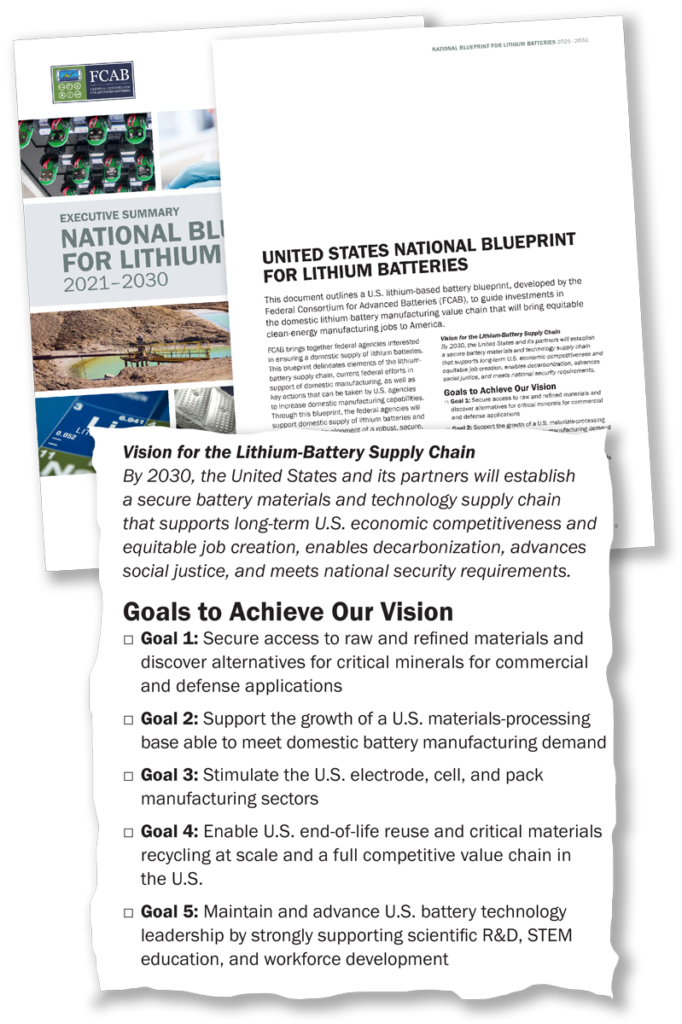
The conundrum – to mine or not to mine – has roiled several rural western communities, from the outskirts of California’s Death Valley to northern Nevada and western Arizona. The arguments vary by location, but belong to a larger debate over how to balance the need to slow global warming with the need to protect endangered species, preserve groundwater and support tribal rights while maintaining heritage sites.
Lithium deposits in the southwest
Lithium, in the United States and South America, often is found under salars, arid areas where inland salt lakes may have evaporated. In red, below, are major lithium deposits in the southwest catalogued by the USGS; highlights indicate current or planned lithium mining or brine extraction projects mentioned in this story.

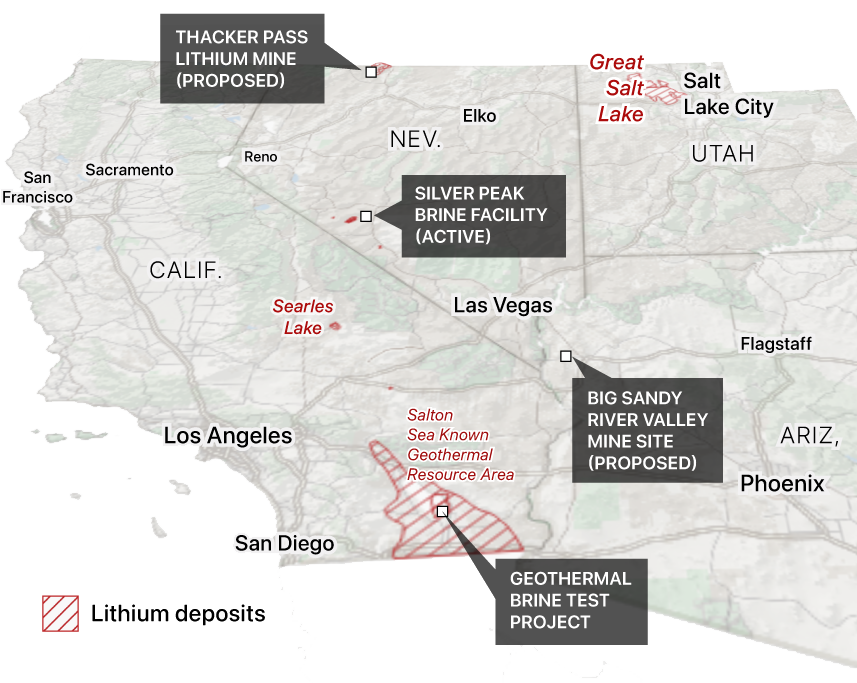
Source: US Geological Survey
Geoff McGhee/Bill Lane Center for the American West
Depending on where the deposit occurs, the process of extracting the lithium can be more, or less, damaging to western lands, species, and historical sites. Lands of significance to Native American groups are spread around the West; and some of these intersect with lithium deposits. Lithium debates echo earlier arguments over solar installations in the desert producing carbon-free electricity or over dams that decimate fish runs but provide carbon-free hydropower.
“These old battles are coming up in a new context,” said Dan Reicher, whose resume includes stints as a former assistant secretary at the federal Energy Department and Google’s director of climate and energy initiatives and is now a senior research scholar at Stanford’s Woods Institute for the Environment. “But the climate overlay has changed the whole equation in a very fundamental way. We have the ultimate threat to the planet. It’s making parties on all sides, in many cases, more willing to negotiate.”
“We have the ultimate threat to the planet. It’s making parties on all sides, in many cases, more willing to negotiate.”
Dan Reicher
The words of Glenn C. Miller support Reicher’s point. Speaking of a proposed lithium mine at Thacker Pass in Nevada, the environmental chemist and longtime opponent of western mines said, “I think every technical person in the environmental community has no problem recognizing that some of these metals are going to be mined. They are important. Without them, we are looking at less reduction in the impacts of climate change.”
But John Hadder, a chemist heading the environmental group Great Basin Resource Watch, countered: “If we lower our guard, what are we letting ourselves in for?” Rick Eichstaedt, a lawyer for the Burns Paiute tribe, which is suing to stop the highly controversial Thacker Pass project, said of the lithium mine project, “We want to be sure a precedent isn’t set because there’s a pet green project in the pipeline.”
Seeking a balance among different environmental imperatives
Deeply felt environmental concerns can collide; traditional anti-mining passions have been seen from the Panamint Valley in eastern California to Thacker Pass in Nevada, where the federal Bureau of Land Management decides on applications to mine lithium. The opposition in the Panamint Valley has subsided since Battery Minerals, Inc., the company proposing lithium extraction, got permission to drill exploratory wells, and drilled two.
But anti-mining passions are white-hot at Thacker Pass in Nevada and the Big Sandy River Valley in western Arizona. At these sites, some tribal members oppose lithium mines on the grounds that mining will despoil lands whose history or use are fundamental to their culture. Other tribal members are more focused on the jobs created by such projects.

In Thacker Pass, a subsidiary of the Canadian company Lithium Americas Corp. seeks to use nearly 18,000 acres of federal land to carve a large open-pit mine and build a facility where sulfuric acid is used to extract the lithium from the mined mud. Trucks would bring in sulfur, an agricultural chemical, on narrow rural roads. A processing facility would turn it into sulfuric acid and use it to leach the lithium from the clay-like ore mined nearby.
Nearby ranchers fear the large amount of water needed for the process could lower groundwater tables. Lawsuits to block the project are pending, though a federal judge refused to halt the work pending her final decision.
Despite ample deposits, the U.S. remains far behind in global lithium race
This intersection of countervailing passions, as environmentalists weigh both the climate imperative and the cost of local environmental harm, comes amid official concern that the U.S. remains an also-ran in lithium production. A 2020 Institute for Defense Analyses report noted, “There are domestic reserves of lithium but currently little domestic mine production. With respect to refining, about half the lithium refining capacity is concentrated in China, followed by Chile and Argentina.” The lightweight metal is often found under salars, or arid areas where inland salt lakes may have evaporated.
Lithium can be contained in clay, minerals, and brine, and either leached out with acid, dissolved, or refined.
How much lithium is there? The complexity in measuring the weight of available lithium mirrors the complications of extracting it from different deposits. Lithium can be contained in clay, minerals, and brine, and either leached out with acid, dissolved, or refined. The industry’s common measurement is a “lithium carbonate equivalent.” The weight of LCE is a little more than five times that of the lithium it contains.
The Thacker Pass plan envisions a 41-year project of extracting lithium carbonate, starting with 30,000 metric tons annually and growing to 60,000 metric tons annually. Four conservation groups have joined to oppose it.
Under an ‘accidental lake,’ backers tout lithium leached from brines
Under California’s Salton Sea is a different lithium deposit, potentially much larger than the one at Thacker Pass, but one whose extraction could be less harmful to the environment, if the technology being tested works.
Extracting lithium from brines is not new in the Southwest, it has been practiced for years at the Silver Peak facility in Esmeralda County, Nevada; the owner, a North Carolina-based firm Albermarle, is expanding production. The company creates large evaporation ponds for the brine and uses large amounts of water; the evaporation process can take 18 months.

A different, far less water-intensive process using brine, is being tested in Imperial County in southeastern California. Lithium is locked in hot brine nearly a mile below the Salton Sea – an accidental lake full of agricultural runoff, whose relentless evaporation has left its shores covered in toxic dust. If the method being tested works, it could mean production of 10 times the amount at Thacker Pass with a fraction of the water used at Silver Peak.
The economic and clean-energy potential of an area backers are calling “Lithium Valley” is a central focus of California energy experts, state government, and local officials in impoverished Imperial County. A 2020 California Energy Commission report said, “The current price of lithium carbonate is about $12,000 per ton, and the Salton Sea Known Geothermal Resource Area is capable of producing an estimated 600,000 tons per year of lithium carbonate with a value of $7.2 billion.”
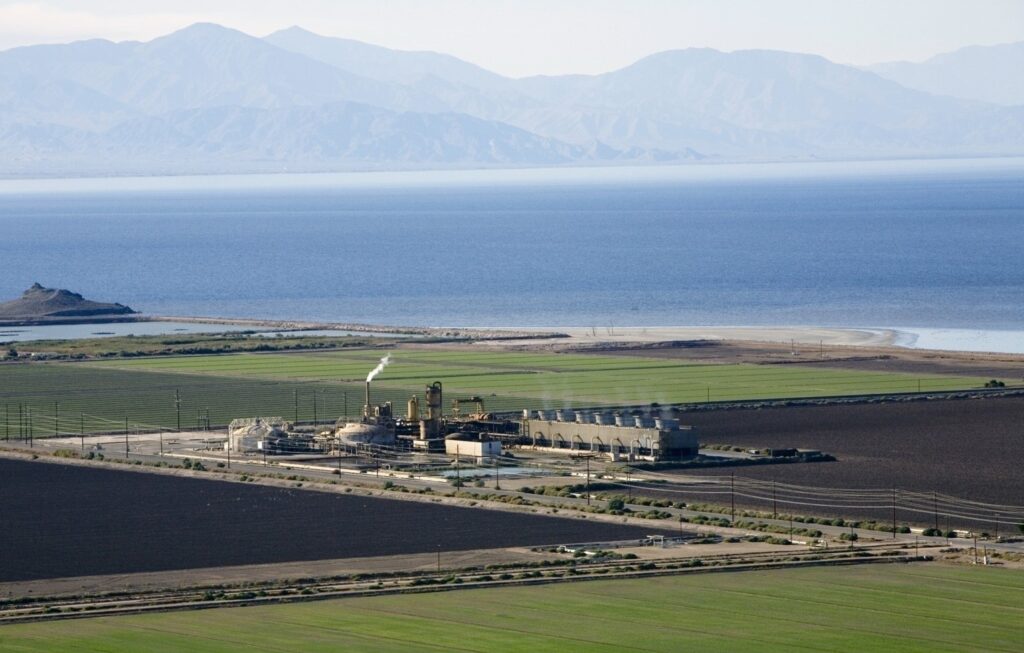
The world’s current annual production was estimated at 431,000 metric tons of LCE in 2020, which yielded 82,000 metric tons of lithium.
Three companies are in the forefront of the Imperial Valley lithium push: Energy Source Minerals, the Australian firm Controlled Thermal Resources, which has already contracted with General Motors to sell its future lithium production, and Berkshire Hathaway Energy, which has been extracting brine to operate geothermal energy plants since 1982.
Ten geothermal plants already use the brine containing lithium to generate about 345 megawatts of power annually.
BHE’s 10 geothermal plants – including 23 production wells and 21 wells used to reinject the brine into the ground – already use the brine containing lithium to generate about 345 megawatts of power annually. Jonathan Weisgall, a vice president for government relations at Berkshire Hathaway Energy, said that his company’s approach to refining lithium from brines will use “at least 90 percent less” water than other methods.

Could there be success in producing energy, lithium, and jobs?
The state’s optimistic vision is a trifecta for the Salton Sea region – companies producing energy, lithium, and jobs, including the possibility of attracting battery manufacturers to the area. The California Energy Commission in March of last year awarded $10 million in grants for lithium exploration, including a $6 million grant to Berkshire Hathaway Energy to create a pilot operation at 10 percent of the size of the one they aim to build.
Nowhere to be seen is the indigenous group opposition found at Thacker Pass. Two years ago the local Torres Martinez Desert Cahuilla Indian community sent a letter of support for Berkshire Hathaway’s project, saying it would bring “400 high-paying jobs” and be “far more environmentally sound than traditional lithium-recovery methods today, which rely on either environmentally destructive evaporation ponds… or open-pit mining.…”
Even with the support by the state and local officials and the small footprint of the project, some opposition simmers.
But, even with the support by the state and local officials and the small footprint of the project, some opposition simmers. The fear, perhaps linked to the dust storms filling the air with toxic material from the receding Salton Sea, is that the project will harm public health. The process to be used allows direct lithium extraction within the existing geothermal closed loop process. No evidence of danger exists, but opponents want evidence there’s no danger.
One commenter at a Nov. 17 public forum on Zoom wrote in the chat, “The benefits do not outweigh the risks in public health…. Public health is not negotiable.” Another wrote, “If this is brand new, why experiment on us?” But to date there have been no public protests.
The potential benefit and potentially small environmental footprint of lithium extraction near the Salton Sea could set it apart from other industrial projects that reduce greenhouse-gas emissions and slow climate change.
While environmental groups lack consensus, public opposition can stop a project in its tracks
But public opposition can kill clean-energy projects in the West. A few months ago, the developers planning the country’s largest solar panel project, covering 14 square miles and sitting atop the scenic Mormon Mesa north of Las Vegas, pulled out. Local residents successfully fought the proposed 850-megawatt project, decrying their loss of the mesa view and of hiking and camping land.

Public comment session during Lithium Valley Commission Zoom meeting in Nov. 2021
“Whether it’s lithium or any number of other things, [the arguments] often take you to the difference between local groups and national groups,” said Reicher. Frank Maisano, an energy company lobbyist, added, “There’s always going to be a local element that drives environmental communities.” The high profile of environmental justice issues makes the tribal protests at Thacker Pass more consequential.
Reicher remains hopeful, based on his experience as an integral player in the resolution of major arguments over hydroelectric dams. Hydropower operators and environmental groups reached a major agreement 13 months ago – and will get billions of dollars in support from the new infrastructure bill – allowing for more hydropower and less environmental damage from dams.
“Overall, things are changing,” Reicher said “The climate imperative is beginning to sink in even for groups that might be fighting a project in their backyard.”
The change he talks of is still a work in progress in lithium country. The Sierra Club is trying to square the circle and offer clear guidance on assessing new lithium projects. It hasn’t yet succeeded. In a recent letter presenting its lengthy statement on lithium mining, the Club’s conservation policy committee offered no opinion on the Salton Sea geothermal brine projects, saying it didn’t know enough.
As for projects like the proposed open-pit mine at Thacker Pass, the group punted, saying, “We hand off the dilemma of how to tightly balance” the club’s mining policy and its respect for indigenous rights “against the need for new materials in a just energy transition.”
The climate imperative hasn’t ended the arguments over lithium extraction in the West.
Edited by Geoff McGhee.
Read Next in …& the West
How the U.S. legal system ignores tribal law: Q&A with Elizabeth Reese
Stanford Law School’s first Native American professor discusses the marginalization of tribal legal structures.

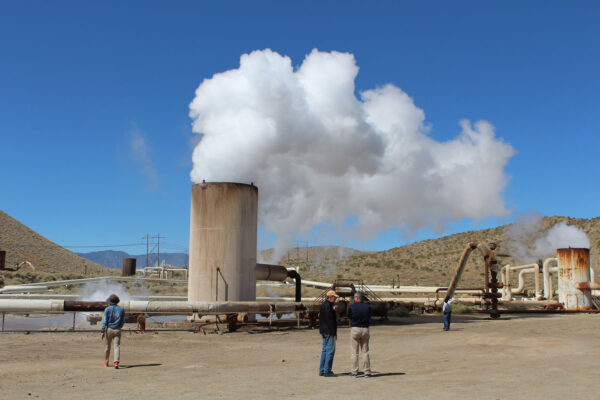






























One reply on “Car batteries are the goal. Lithium is the quickest way to make them. Does a global good require local sacrifice in the Southwest?”
[…] the full article here […]